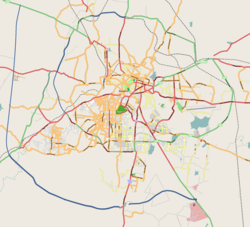This article needs additional citations for verification .(December 2021) |
Yeshwanthapura Yeshwanthpur Yesvantpur | |
|---|---|
neighborhood | |
 Flyover at Yeshwanthapura Junction | |
| Coordinates: 13°01′43″N77°32′46″E / 13.0285°N 77.54620°E | |
| Country | India |
| State | Karnataka |
| District | Bangalore Urban |
| Metro | Bangalore |
| Languages | |
| • Official | Kannada |
| Time zone | UTC+5:30 (IST) |
| PIN | 560022 |
| Vehicle registration | KA 04 |
Yeshavantapura (formerly Yeshwanthpur), also known as Yeshvantpur, is a locality in the northwestern part of Bangalore in the Indian state of Karnataka. It is located to the north of Malleshwara and west of Hebbala. The biggest wholesale market for agricultural produce in the city, the Yeshwanthpur APMC Yard, is situated in the locality. [1] [2] The green line of Namma Metro [3] passes through Yeshwanthpur Metro Station and allows connectivity to all the extensions of the city.
